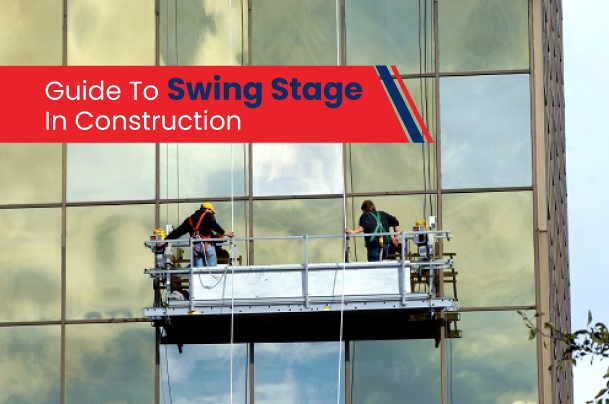
Scaffolding is something you see a lot on construction sites. It’s a setup of poles and planks that helps workers reach higher parts of a building.
One important type of scaffolding is the swing stage. It’s especially used for tall buildings and has special safety rules.
Swing stage construction involves the use of suspended platforms to help workers access tall buildings. These platforms are suspended from the top of a building and can be adjusted to different heights, making them versatile for various construction tasks.
In this article, we’ll talk about the important safety features of swing stages and give tips on how to use them safely.
Whether you work in construction or are just interested in how things work, this post will give you helpful and easy-to-understand information.
How Does Swing Stage Scaffolding Work?
Swing staging uses cables attached to a rigging system at the top of the building. Regular scaffold parts are supported by a frame on the ground. It is good for long-term projects or shorter buildings. However, it’s expensive and takes a lot of time to set up.
In a swing stage setup, cables go through supports on the side of the platform. This allows workers to raise or lower the platform as needed. A motor helps move the platform up and down quickly, saving time. There are different sizes and weight capacities for platforms and cables. During swing stage construction, regular inspections of equipment and safety measures are essential to prevent accidents and ensure compliance with industry standards. This makes it useful for tasks like painting, cleaning, repairs, and installations.
Swing stage scaffolding is lightweight. It is easy to set up and take down. It can move around easily. This makes it a cost-effective choice for jobs that need to transport materials and reach high or hard-to-access spots.
Swing stage construction requires careful planning and adherence to safety regulations. Workers use harnesses and safety gear to ensure their protection while working at heights.
How Long Can a Swing Stage be?
Swing stages, also known as two-point suspension scaffolds, can be 3 to 72 feet long, and even longer if needed. They can be set up with one, two, or multiple support points.
The process of swing stage construction begins with securing anchor points on the building’s rooftop or facade. These anchor points support the weight of the suspended platform and ensure stability during work.
How Much Weight Can a Swing Stage Hold?
How much weight a swing stage setup can hold depends on how it’s made and what the manufacturer says. Usually, swing stages can hold between 500 and 2,000 pounds. Always check the guidelines for the specific model to use it safely and not go over the weight limit.
One of the main advantages of swing stage construction is its ability to provide easy access to different parts of a building’s exterior, allowing for efficient maintenance, painting, or repairs.
Are Swing Stages Safe?
Yes, swing stages are safe when used properly. They must be set up correctly and maintained well. Workers should follow safety guidelines, use the right equipment, and avoid overloading the platform. Regular inspections and proper training are also important to ensure safety.
Engineers and construction workers undergo specialized training to operate swing stage construction equipment safely. This training includes understanding weight limits, platform stability, and emergency procedures.
How Much Does A Swing Stage Cost?
Renting a swing stage typically costs between $1,600 and $2,000 per month, but prices can be higher depending on factors like platform length, building height, and attachment method. Renting is practical for shorter projects like painting entire buildings, basic maintenance, or fixing cracks. It saves you from storing, maintaining, certifying annually, and transporting equipment.
Buying a swing stage can range from $27,000 to $35,000. It’s better for long-term projects or frequent use. However, ownership means managing maintenance, certifications, and potential recalls. Additional accessories like boosters, transformers, and extra rigging may also be necessary for future jobs.
The flexibility of swing stage construction makes it ideal for projects where traditional scaffolding may not be practical due to space constraints or architectural complexity.
Ensuring Safety with Swing Stages
Safety is crucial in construction, especially when using swing stages. Paying attention to details can prevent accidents and ensure smooth operations.
Here are key safety tips for using swing stages:
- Platform Design: Ensure the platform is strong enough for the load and clear of debris. Non-slip surfaces are vital for worker safety.
- Fall Protection: Guardrails, mid-rails, toe boards, and full-body harnesses with lifelines are essential to prevent falls.
- Weather Awareness: Wind, rain, or snow can affect the stability of swing stages. Check weather conditions and have backup plans.
- Regular Inspections: Before each use, inspect the swing stage for damage. This includes the platform, supports, and fall protection gear.
- Training: Only trained workers should operate swing stages. Training should cover equipment use, safety procedures, and emergencies.
- Emergency Preparedness: Have emergency descent devices and procedures in case of platform failure. Conduct drills to ensure everyone knows what to do.
Following these safety measures ensures that using swing stages is as safe as possible on construction sites.
As technology advances, new safety features and materials are continually being integrated into swing stage construction equipment, enhancing worker safety and efficiency on job sites.
Scaffolds Supply
Safety and best scaffolding accessories supplier is top priority on every construction site. When you need trustworthy scaffolding solutions and expert training, choose Scaffolds Supply.
With over 70 years of industry leadership, we deliver unmatched quality, reliability, and expertise. From frame and system scaffolding to suspended platforms and steel shoring, we handle it all safely and efficiently.
Partner with us for your next project and experience the difference with Scaffolds Supply.











Comments are closed